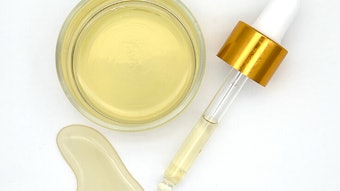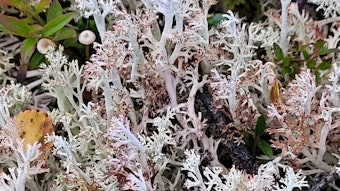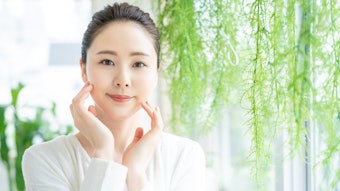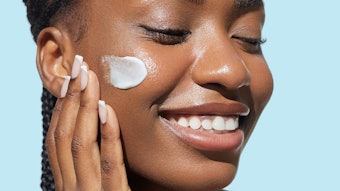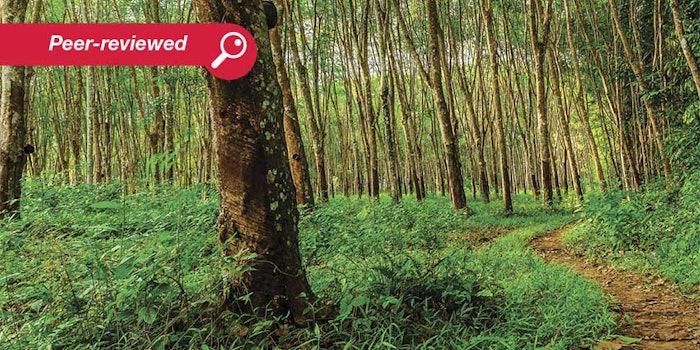
To read this article in its entirety, click through to your March 2020 digital magazine. . .
The expectation that consumer products are sustainable has dramatically increased, and as such, the cosmetics sector continues the exhaustive search for new sources. One major challenge to identifying renewable materials for cosmetics is finding those from common crops that are also economically feasible.
Para rubber, or simply rubber, is a well-known natural raw material from trees that serves as the source for more than 40,000 products in manufacturing.1, 2 A by-product of rubber production is its seed, which while renewed annually, is not always germinated to yield new plants. This seed offers a sustainable and natural source with cosmetic potential, as its antioxidant, cleansing and skin-lightening properties, reviewed below in brief, demonstrate; full data and details are reported elsewhere and provided in the references.
In vitro Evaluations
Preparation and standardization of the seed oil: The seeds of para rubber, a major crop in Thailand, were harvested from the RRIM 600 (Rubber Research Institute of Thailand) cultivar, and extracted via a patented method developed to produce a standardized para rubber seed oil.3, 4
Fatty acid analysis: The content of key fatty acids, important to cosmetics, were analyzed and validated in the extracts by gas chromatography (GC). These included palmitic acid, stearic acid, oleic acid and linoleic acids.4
Antioxidant activities: The antioxidant potential of the oil, typically aligned with anti-aging claims, was assessed by 2, 2´–azino-bis(3-ethylbenzothiazoline)-6-sulfonic acid (ABTS) and 1,1-diphenyl-2-picrylhydrazyl (DPPH) assays, and compared with standards.4
Safety in human skin fibroblasts: The safety profile of the oil was investigated in vitro in human fibroblasts.4
Activity and safety in 3T3-L1 cells: In addition, the safety profile of the oil was determined in 3T3-L1 cells, and the antioxidant activity was analyzed at the dosage levels deemed safe.5
Skin lightening and safety in B16F10 melanoma cells: The cytotoxicity of the extract in B16F10 melanoma cells was examined as well, as were its inhibitory effects against melanogenesis, tyrosinase and tyrosinase related proteins-2 (TRP-2). Activities were thereafter assessed at the extract’s safe concentration.5
Physicochemical properties: Finally, in vitro, the specific gravity, refractive index, iodine value, peroxide value and saponification value of the extract were determined, as were color parameters, i.e., L*, a*, b*.3, 4
Test Makeup Remover
Beyond the properties of the para rubber seed oil itself, its application was assessed in variations of a test makeup remover (see Formula 1). The physicochemical properties of the product were evaluated, and its stability was determined by means of a centrifugation assay and seven heat-cool cycles.6
The in vitro efficacy of the product’s makeup removal capabilities were measured using a validated method.7-9 The parameters were compared and analyzed by software using one sample t-test and the ANOVA with a significance level of p < 0.05.
Results In vitro
Standardized extraction: The patented extraction process of para rubber seed oil for industrial scale was deemed feasible and concise,3 providing a yield of 18-20%.
Fatty acid content: The active fatty acids were quantified as shown in Figure 1. The oil contained a majority of oleic and linoleic acids, followed by palmitic and stearic acids.3-5 Linoleic acid is an important fatty acid with skin-, hair- and nail-nourishing properties. It also exhibits anti-inflammatory activities for dandruff and hair loss treatment, with the added function of helping to promote hair growth. Thanks to its anti-inflammatory effects, it also is applied in cosmetics for acne.10
Palmitic acid is commonly used in cleansing products as well as cosmetics, e.g., creams and lotions, in dosage forms similar to stearic acid. Oleic acid is one of the most well-known ingredients in cosmetics for its skin-enhancing potency.
All of these fatty acids are applicable in cosmetics as active and functional ingredients, especially for their cleansing abilities.7, 9 Thus, the prepared para rubber seed oil presented constituents useful for cosmetic applications. Next, it was challenged for radical-scavenging activities.
Antioxidant effects: The ability of the oil to scavenge ABTS•+ was expressed as its Trolox equivalent antioxidant capacity (TEAC), which was 59-74 mg/100 g of the oil. In addition, at 1 mg/mL, the oil scavenged 7-11% of DPPH radicals (data not shown).3, 4
In relation, since some antioxidants exhibit anti-melanogenesis properties, the cellular activity as well as safety of the oil in cell cultures was assessed next, followed by its potential skin lightening effects.
Extract safety: Para rubber seed oil was found to be non-toxic to human fibroblasts at a test concentration of 31.25–500 µg/mL.3, 4 Its safety was confirmed. . .
. . .Read more in the March 2020 digital edition. . .
References
- van Beilen, J.B. and Poirier, Y. (2007). Establishment of new crops for the production of natural rubber. Trend Biotechnol 25 522-529.
- Nair, K.P.P. (2010). Rubber (Hevea brasiliensis). In: The Agronomy and Economy of Important Tree Crops of the Developing World. Elsevier, Miami. 237-273.
- Lourith, N. and Kanlayavattanakul, M. (2016, Nov 15). Preparation of para rubber seed oil for uses as a component in cosmetic products. Thailand Patent No. 157585. Int Cl 10 A61Q 19/00, A61K 36/47.
- Lourith, N., Kanlayavattanakul, M., Sucontphunt, A. and Ondee, T. (2014). Para rubber seed oil: New promising unconventional oil for cosmetics. J Oleo Sci 63 709-716.
- Chaikul, P., Kanlayavattanakul, M. and Lourith, N. (2017). Antimelanogenesis and cellular antioxidant activities of rubber (Hevea brasiliensis) seed oil for cosmetics. Ind Crop Prod 108 56-62.
- Lourith, N. and Kanlayavattanakul, M. (2018, Jun 20). Cosmetic make-up removal product containing para rubber seed oil. Thailand Paddy Patent No. 14039. Int Cl 10 A61K 8/00, A61Q 1/00, A61K 8/02, A61K 8/97.
- Charoennit, P. and Lourith, N. (2012). Validated UV-spectrophotometric method for the evaluation of the efficacy of makeup remover. Int J Cosmet Sci 34 190-192.
- Lourith, N. and Kanlayavattanakul, M. (2014). Removal methods and evaluation of removal of makeup products.
In: Barel, A.O., Paye, M. and Maibach, H.I., eds, Handbook of Cosmetic Science and Technology, 4th edn. CRC Press: Florida 453-457. - Parnsamut, N., Kanlayavattanakul, M. and Lourith, N. (2017). Development and efficacy assessments of tea seed oil makeup remover. Ann Pharm Fr 75 189-195.
- Kanlayavattanakul, M. and Lourith, N. (2011). Therapeutic agents and herbs in topical application for acne treatment. Int J Cosmet Sci 33 289-297.




